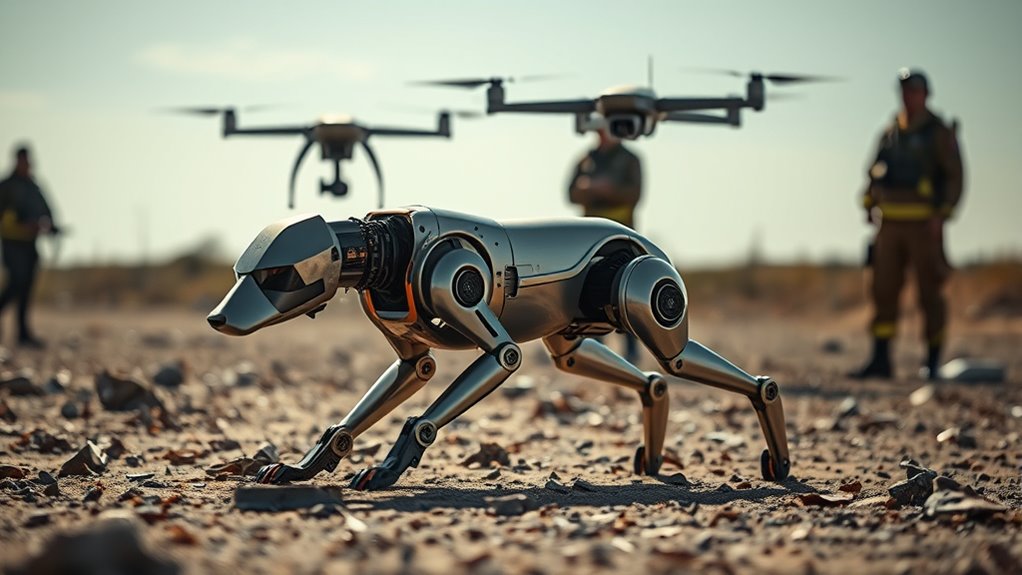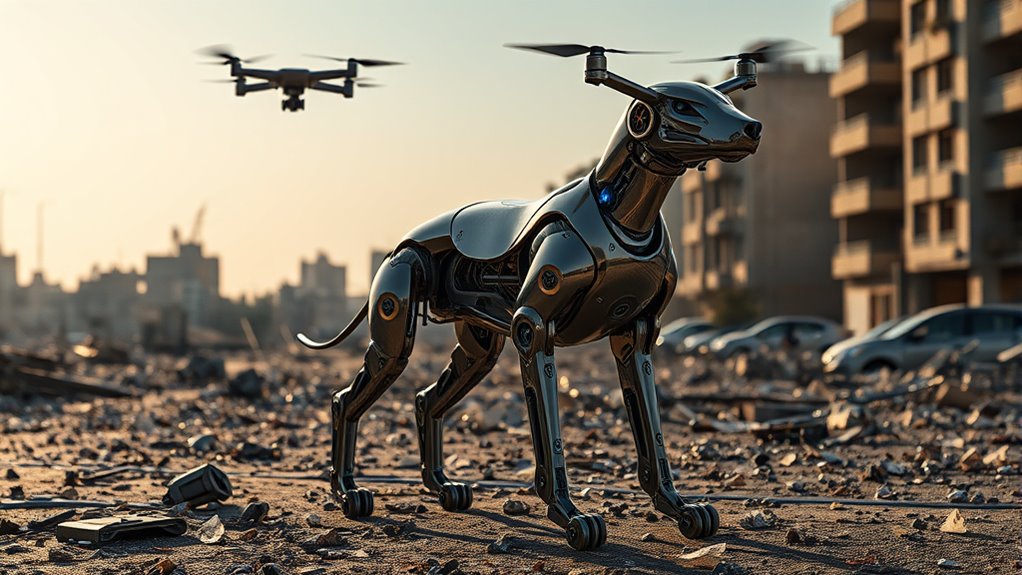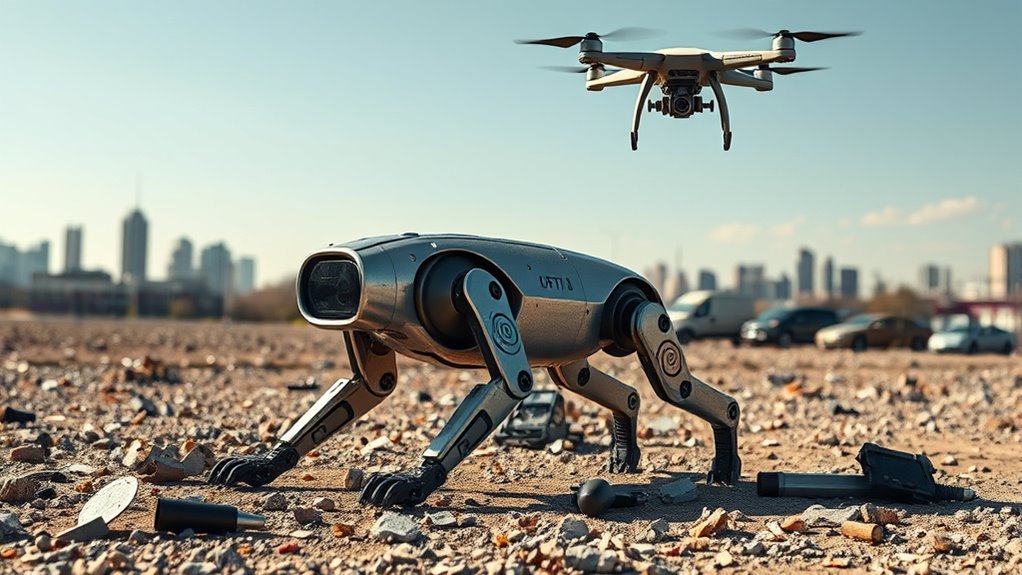Robotic dogs and drones are transforming bomb disposal operations by enhancing safety and efficiency. With advanced sensors and AI, they can navigate complex terrains and detect explosives in real-time. These technologies reduce human risk and improve decision-making, making missions faster and more effective. As military and commercial sectors collaborate, we’re witnessing rapid advancements. You’ll discover how these innovations are shaping the future and what that means for bomb disposal operations moving forward.
Key Takeaways
- Robotic dogs enhance bomb disposal safety by autonomously navigating complex environments and neutralizing threats without risking human lives.
- Drones offer safe surveillance, utilizing advanced sensors for real-time threat detection and reducing human exposure to explosive hazards.
- AI integration in robotic systems improves decision-making and operational efficiency during bomb disposal missions, adapting to dynamic battlefield conditions.
- The modular design of robotic technologies allows for customization, enabling rapid deployment and effective response to various explosive scenarios.
- The global market for bomb disposal robots is expected to grow significantly, reflecting increasing reliance on robotics in military and emergency response operations.
The Role of Robot Dogs in Modern Bomb Disposal

As bomb disposal operations become increasingly complex, robot dogs play an essential role in enhancing safety and efficiency on the field.
Robot dogs are revolutionizing bomb disposal, significantly improving safety and efficiency in complex operations.
These advanced machines can autonomously navigate difficult terrains, open doors, and climb stairs, performing tasks that once required human intervention. Equipped with cutting-edge sensors and AI, they detect explosives in real-time, greatly reducing risks for military personnel.
Their ability to neutralize threats using disruptors makes them invaluable in combat zones. Successful real-world trials showcase their effectiveness, and ongoing collaboration between military and commercial sectors drives further innovation.
As robot dogs continue to evolve, their integration into regular operations promises to enhance safety and operational speed, ultimately reinforcing national security.
Drones: Enhancing Surveillance and Threat Detection

Drones are revolutionizing surveillance and threat detection in bomb disposal operations, allowing teams to assess situations from a safe distance.
With autonomous navigation systems, these drones can independently survey complex terrains, whether urban or rural. Equipped with cutting-edge sensors like electromagnetic detectors and ground-penetrating radar, they provide real-time data for precise threat identification.
Advanced AI algorithms enhance decision-making, utilizing neural networks and machine learning for improved threat recognition. This integration allows for thorough threat analysis through sensor fusion.
By automating reconnaissance, drones greatly increase operational efficiency and reduce human risk, making them invaluable in counter-terrorism efforts and military operations.
Ultimately, they’re transforming how you approach bomb detection and guarantee safety.
Key Technological Features of Robotic Dogs

Robotic dogs are redefining bomb disposal with their cutting-edge technological features, making them essential tools in hazardous environments.
Equipped with advanced sensor technology, these robots can classify potential threats before taking action. Their autonomous navigation allows them to traverse complex terrains, including stairs, while performing various tasks that once relied on human personnel.
Equipped with advanced sensors, robotic dogs navigate complex terrains, classifying threats and performing vital tasks previously reliant on human personnel.
You can control them remotely, minimizing your exposure to danger. With artificial intelligence, they make precise, real-time decisions and analyze data to identify threats effectively.
Their durable materials guarantee they withstand harsh conditions, and their multifunctionality means they can open doors and inspect IEDs.
These features collectively enhance safety and efficiency in bomb disposal operations, making robotic dogs invaluable in critical situations.
Operational Advantages of Using Robotics in EOD

The advancements in robotic dogs have paved the way for notable operational advantages in explosive ordnance disposal (EOD). By reducing human exposure to explosive threats, these robots considerably lower casualty risks.
They assess dangers from a safe distance, using advanced sensors for essential data collection. Unlike humans, robots aren’t affected by fatigue or stress, ensuring consistent performance in high-pressure situations.
Their ability to navigate complex terrains and adapt to various explosive types enhances operational efficiency. With rapid deployment and real-time data analysis, mission times are reduced.
Additionally, their modular design allows for customization, making them versatile for different scenarios. Overall, robotics revolutionize EOD, providing safety and efficiency in critical operations.
Trials and Testing: Proving the Technology

While evaluating the effectiveness of advanced technologies in bomb disposal, trials conducted by the Defence Science and Technology Laboratory (Dstl) showcased considerable progress in robotics.
Over four days, Dstl collaborated with industry partners to test robotic systems, including Boston Dynamics robot dogs and AI-powered drones. These trials aimed to assess how well robots could reduce personnel risk and enhance efficiency in bomb disposal operations.
Scenario-based exercises challenged the robots with tasks like maneuvering stairs and inspecting IEDs. You’d see robot dogs autonomously detecting explosives and neutralizing threats with remote-controlled disruptors.
Drones improved operational speed and monitored safety cordons. These advancements highlight the potential for robotics to revolutionize bomb disposal and considerably improve public safety.
Future Outlook for Robotic Solutions in Defense

As trials have shown, the potential for robotic solutions in defense is only just beginning to be fully realized.
The global military robotics market is projected to reach $25 billion by 2028, indicating a strong commitment to technological advancements. You’ll see AI integration enhancing autonomous systems and improving mission efficiency.
Robots can perform tasks like reconnaissance and bomb disposal with unmatched precision, while advanced sensors enable real-time threat detection. Their ability to autonomously navigate complex environments reduces risks to human soldiers.
With adaptability and quick reconfiguration, these robots become crucial assets in dynamic warfare. As nations invest in these technologies, expect them to shape future defense strategies and set new standards for operational effectiveness and public safety. Additionally, hydrogen fuel cells are being explored to power these robotic systems, offering a sustainable energy source for future operations.
The Global Impact of AI and Robotics in Bomb Disposal

Integrating AI and robotics into bomb disposal operations is revolutionizing safety protocols and operational efficiency worldwide. The global bomb disposal robot market is set to reach USD 32.50 billion by 2032, fueled by AI and IoT advancements.
Robotic dogs and drones enhance safety by autonomously performing tasks like identifying explosives and opening doors, greatly reducing human risk. With real-time decision-making capabilities, these technologies can analyze bomb threats quickly and accurately.
Collaborative efforts between companies like L3Harris and AeroVironment are driving innovation, ensuring that military and civilian safety standards are met globally. As trials in the UK demonstrate their effectiveness, these advancements promise to transform EOD operations, making our world a safer place.
Frequently Asked Questions
How Are Robotic Dogs Powered During Operations?
Robotic dogs are powered during operations primarily through advanced battery systems designed for energy efficiency.
You’ll find that their operational duration hinges on these batteries, which are optimized for various tasks. They use smart power management to maximize energy use, adapting to terrain and task requirements.
Additionally, rapid-charging infrastructure supports quick recharges, ensuring these robots remain operational without lengthy downtime, making them effective in challenging environments.
What Are the Costs Associated With Deploying Robotic Solutions?
Imagine a knight in shining armor, but instead of a horse, it’s a robotic dog ready for battle.
When it comes to deploying robotic solutions, you’re looking at costs that can range from tens of thousands to several hundred thousand dollars.
Factors like advanced technology, manufacturer reputation, and customization play a big role in pricing.
While it’s a hefty investment, you’re ultimately enhancing safety and operational efficiency, making it worth every penny.
How Do Robotic Dogs Communicate With Human Operators?
Robotic dogs communicate with you through secure wireless networks, ensuring data remains confidential.
They use advanced sensors to gather real-time information, sending it back to you via encrypted channels.
You receive instant updates and detailed feedback through a user-friendly interface that features high-resolution visuals and audio alerts.
This allows you to monitor their actions closely and make informed decisions, enhancing both safety and effectiveness during operations in challenging environments.
What Training Is Required for Operators of These Technologies?
Imagine stepping into the shoes of a high-tech warrior, where every move counts.
To operate robotic dogs and drones effectively, you’ve gotta master advanced robotics and EOD procedures. You’ll train in simulated environments, honing risk assessment and communication skills.
Familiarity with sensor technology and navigation systems is key, alongside tactical planning and adaptability.
This isn’t just technology; it’s about blending human instinct with robotic precision to guarantee safety and success.
Are There Ethical Concerns Regarding the Use of Robots in Bomb Disposal?
Yes, there are significant ethical concerns regarding the use of robots in bomb disposal.
You might worry about the lack of human judgment in autonomous systems, which could lead to unintended consequences. It’s vital to guarantee human oversight during operations to make ethical decisions, especially when lives are at stake.
Additionally, the reliance on technology raises questions about accountability and the need for international regulations to protect civilians and establish clear legal frameworks.
Conclusion
As bomb disposal technology evolves, you’re witnessing a revolution in safety and efficiency. With robotic dogs traversing hazardous terrains and drones enhancing surveillance, the future looks promising. These innovations aren’t just tools; they’re game-changers, transforming how we approach explosive ordnance disposal. By embracing these advancements, you’re not only protecting lives but also paving the way for smarter, safer operations. In this new era, robotics and AI are leading the charge, ensuring a more secure world for everyone.









